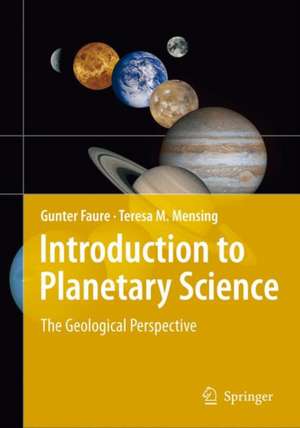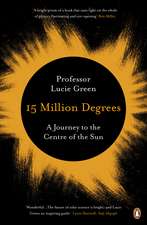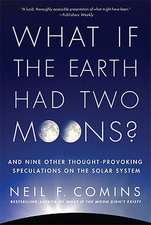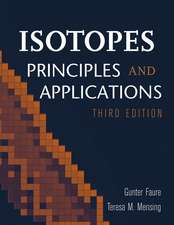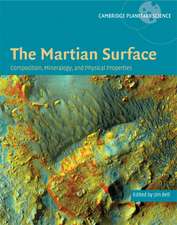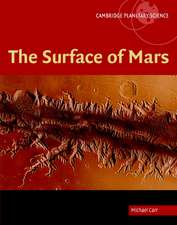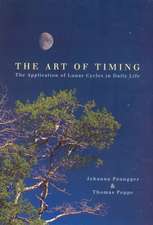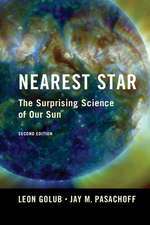Introduction to Planetary Science: The Geological Perspective
Autor Gunter Faure, Teresa M. Mensingen Limba Engleză Hardback – 12 apr 2007
The subject matter is presented in 24 chapters that lead the reader through the solar system starting with historical perspectives on space exploration and the development of the scientific method. The presentations concerning the planets and their satellites emphasize that their origin and subsequent evolution can be explained by applications of certain basic principles of physics, chemistry, and celestial mechanics and that the surface features of the solid bodies in the solar system can be interpreted by means of the principles of geology.
| Toate formatele și edițiile | Preț | Express |
|---|---|---|
| Paperback (1) | 633.75 lei 6-8 săpt. | |
| SPRINGER NETHERLANDS – 23 aug 2016 | 633.75 lei 6-8 săpt. | |
| Hardback (1) | 822.77 lei 6-8 săpt. | |
| SPRINGER NETHERLANDS – 12 apr 2007 | 822.77 lei 6-8 săpt. |
Preț: 822.77 lei
Preț vechi: 1003.37 lei
-18% Nou
Puncte Express: 1234
Preț estimativ în valută:
145.59€ • 170.72$ • 127.86£
145.59€ • 170.72$ • 127.86£
Carte tipărită la comandă
Livrare economică 13-27 februarie
Preluare comenzi: 021 569.72.76
Specificații
ISBN-13: 9781402052330
ISBN-10: 1402052332
Pagini: 546
Ilustrații: XX, 526 p.
Dimensiuni: 178 x 254 x 27 mm
Greutate: 1.16 kg
Ediția:2007
Editura: SPRINGER NETHERLANDS
Colecția Springer
Locul publicării:Dordrecht, Netherlands
ISBN-10: 1402052332
Pagini: 546
Ilustrații: XX, 526 p.
Dimensiuni: 178 x 254 x 27 mm
Greutate: 1.16 kg
Ediția:2007
Editura: SPRINGER NETHERLANDS
Colecția Springer
Locul publicării:Dordrecht, Netherlands
Public țintă
GraduateCuprins
The Urge to Explore.- From Speculation to Understanding.- The Planets of the Solar System.- Life and Death of Stars.- Origin of the Solar System.- Earth: Model of Planetary Evolution.- The Clockwork of the Solar System.- Meteorites and Impact Craters.- The Earth-Moon System.- Mercury: Too Hot for Comfort.- Venus; Planetary Evolution Gone Bad.- Mars: The Little Planet that Could.- Asteroids: Shattered Worlds.- Jupiter: Heavy-Weight Champion.- Galilean Satellites: Jewels of the Solar System.- Saturn: The Beauty of Rings.- Titan: An Ancient World in Deep Freeze.- Uranus: What Happened Here?.- Neptune: More Surprises.- Pluto and Charon: The Odd Couple.- Ice Worlds at the Outer Limit.- Comets: Coming Inside from the Cold.- Earth: The Cradle of Humans.- Brown-Dwarf Stars and Extrasolar Planets.
Recenzii
From the reviews:
"The authors … have produced a book that is remarkably up to date, nicely illustrated, and written in an engaging style. An especially effective touch us that each chapter ends with one or more scientific briefs … . presents an abundance of fascinating information about our cosmic neighborhood, in a form that is readily accessible to students majoring in Earth science. This text will significantly improve teaching and learning about planetary geoscience, and I will be using it for my own undergraduate course … ."
(Hap McSween, Elements, Vol. 4 (1), 2008)
"This book should be used as the basis for a capstone course for senior undergraduates and beginning graduate students majoring in the Earth sciences. … The book is fairly well up to date in terms of discoveries … . Positive points about the book include clear and abundant illustrations and a well-chosen reference list at the end of each chapter. … well-bound and well-illustrated book. … is comprehensive and balanced in its coverage of bodies in the solar system."
(David A. Rothery, Eos, Vol. 89 (15), 2008)
"When I was asked to review this textbook, I immediately said yes. I expected that I would enjoy reading the book and that I would undoubtedly learn from it either new facts or methods of presenting facts and their interpretation to students. I was not disappointed; in fact, I was delighted. The book captures the essence of modern planetary science in 24 chapters. The chapters do not overload the reader with an abundance of factual details and their interpreatations but instead present issues at a level that can be clearly understood by majors and nonmajors alike but without compromising the science. The book is clearly excellent - if not outstanding - for use in a course for nonmajors, and I highly recommend it. ... The book is not organized in what I consider to be a classic approach, which is actually a delightful change,and it works very well. In addition, the "science briefs" at the ends of chapters are a wonderful affirmation of each theme. Overall, the book is excellent."
(Harold C. Connolly Jr, The Journal of Geology, Vol. 116, p. 313, 2008)
"Introduction to Planetary Sciences – the Geological Perspective … is the brain-child of Gunter Faure and Theresa M. Mensing. … this text not only helps me to acquire new teaching material for my lecture classes, but also exposes me to the latest cosmologic discoveries, told from a geologic point of view. … . It is the authors’ unique ability to intertwine a strong dose of geology, with planetary science, in an easy to understand presentation, that generates the appeal of this book."
(Joseph F. Born Jr., American Association of Petroleum Geologists, Vol. 92 (5), May, 2008)
"A fascinating look at the worlds of our Solar System.
In this excellent textbook, Faure and Mensing succinctly and clearly describe what our Solar System is made of and how it works. Each planet is described in detail-its geology, history, satellites, chemistry, and orbital mechanics. The latest planetary knowledge is presented, and the book is very up-to-date on the latest developments in planetary science, with plenty of new information gleaned from the Hubble Space Telescope and the Cassini Probe. Principles of physics, chemistry, and geology as they pertain to the planets and their celestial mechanics are presented and every chapter is very well-written, clear, and fascinating.
The excellent text is complemented by many brilliant and fascinating pictures in every chapter, including new pictures of the surface of Titan from the Cassini Probe. The high quality of the pictures was a major factor which induced me to buy this book!
I would recommend this as a textbook for a geology class, and for anyone at all who has at least a basic background in science and wants to know more about theother worlds in our solar system and how they operate. It's not a cheap book but it's worth every penny."
(Gordon Trunk, Minneapolis, MN, USA, December 11, 2008)
“This book is a comprehensive review of the current knowledge of planetary sciences. … The book is best suited for upper division undergraduate students and for beginning graduate students. … a reference book on planetary sciences that will serve well the shelves of all Earth scientists. … Due to its holistic and complete approach of the Universe and the Earth’s place within the Universe, this book will benefit not only people involved in the planetary sciences but also all those involved in Earth Sciences.” (Susana Custódio, Pure and Applied Geophysics, Vol. 166, 2009)
"The authors … have produced a book that is remarkably up to date, nicely illustrated, and written in an engaging style. An especially effective touch us that each chapter ends with one or more scientific briefs … . presents an abundance of fascinating information about our cosmic neighborhood, in a form that is readily accessible to students majoring in Earth science. This text will significantly improve teaching and learning about planetary geoscience, and I will be using it for my own undergraduate course … ."
(Hap McSween, Elements, Vol. 4 (1), 2008)
"This book should be used as the basis for a capstone course for senior undergraduates and beginning graduate students majoring in the Earth sciences. … The book is fairly well up to date in terms of discoveries … . Positive points about the book include clear and abundant illustrations and a well-chosen reference list at the end of each chapter. … well-bound and well-illustrated book. … is comprehensive and balanced in its coverage of bodies in the solar system."
(David A. Rothery, Eos, Vol. 89 (15), 2008)
"When I was asked to review this textbook, I immediately said yes. I expected that I would enjoy reading the book and that I would undoubtedly learn from it either new facts or methods of presenting facts and their interpretation to students. I was not disappointed; in fact, I was delighted. The book captures the essence of modern planetary science in 24 chapters. The chapters do not overload the reader with an abundance of factual details and their interpreatations but instead present issues at a level that can be clearly understood by majors and nonmajors alike but without compromising the science. The book is clearly excellent - if not outstanding - for use in a course for nonmajors, and I highly recommend it. ... The book is not organized in what I consider to be a classic approach, which is actually a delightful change,and it works very well. In addition, the "science briefs" at the ends of chapters are a wonderful affirmation of each theme. Overall, the book is excellent."
(Harold C. Connolly Jr, The Journal of Geology, Vol. 116, p. 313, 2008)
"Introduction to Planetary Sciences – the Geological Perspective … is the brain-child of Gunter Faure and Theresa M. Mensing. … this text not only helps me to acquire new teaching material for my lecture classes, but also exposes me to the latest cosmologic discoveries, told from a geologic point of view. … . It is the authors’ unique ability to intertwine a strong dose of geology, with planetary science, in an easy to understand presentation, that generates the appeal of this book."
(Joseph F. Born Jr., American Association of Petroleum Geologists, Vol. 92 (5), May, 2008)
"A fascinating look at the worlds of our Solar System.
In this excellent textbook, Faure and Mensing succinctly and clearly describe what our Solar System is made of and how it works. Each planet is described in detail-its geology, history, satellites, chemistry, and orbital mechanics. The latest planetary knowledge is presented, and the book is very up-to-date on the latest developments in planetary science, with plenty of new information gleaned from the Hubble Space Telescope and the Cassini Probe. Principles of physics, chemistry, and geology as they pertain to the planets and their celestial mechanics are presented and every chapter is very well-written, clear, and fascinating.
The excellent text is complemented by many brilliant and fascinating pictures in every chapter, including new pictures of the surface of Titan from the Cassini Probe. The high quality of the pictures was a major factor which induced me to buy this book!
I would recommend this as a textbook for a geology class, and for anyone at all who has at least a basic background in science and wants to know more about theother worlds in our solar system and how they operate. It's not a cheap book but it's worth every penny."
(Gordon Trunk, Minneapolis, MN, USA, December 11, 2008)
“This book is a comprehensive review of the current knowledge of planetary sciences. … The book is best suited for upper division undergraduate students and for beginning graduate students. … a reference book on planetary sciences that will serve well the shelves of all Earth scientists. … Due to its holistic and complete approach of the Universe and the Earth’s place within the Universe, this book will benefit not only people involved in the planetary sciences but also all those involved in Earth Sciences.” (Susana Custódio, Pure and Applied Geophysics, Vol. 166, 2009)
Textul de pe ultima copertă
This textbook is intended to be used in a lecture course for college students majoring in the Earth Sciences. Planetary Science provides an opportunity for these students to apply a wide range of subject matter pertaining to the Earth to the study of other planets of the solar system and their principal satellites. As a result, students gain a wider perspective of the different worlds that are accessible to us and they are led to recognize the Earth as the only oasis in space where we can live without life-support systems.
The subject matter is presented in 24 chapters that lead the reader through the solar system starting with historical perspectives on space exploration and the development of the scientific method. The presentations concerning the planets and their satellites emphasize that their origin and subsequent evolution can be explained by applications of certain basic principles of physics, chemistry, and celestial mechanics and that the surface features of the solid bodies in the solar system can be interpreted by means of the principles of geology.
The subject matter is presented in 24 chapters that lead the reader through the solar system starting with historical perspectives on space exploration and the development of the scientific method. The presentations concerning the planets and their satellites emphasize that their origin and subsequent evolution can be explained by applications of certain basic principles of physics, chemistry, and celestial mechanics and that the surface features of the solid bodies in the solar system can be interpreted by means of the principles of geology.
- Organized in a hierarchical manner so that every chapter builds on preceding ones
- Abundantly illustrated with diagrams and color images
- Includes problem sets and a glossary
Caracteristici
Designed to be comprehensible to students at colleges and universities Emphasizes certain basic principles that help to unify the study of the solar system Organized in a hierarchical manner so that every chapter builds on preceding ones Well illustrated with diagrams and color photographs all of which have explanatory captions that reinforce and amplify the information provided Includes supplementary material: sn.pub/extras
